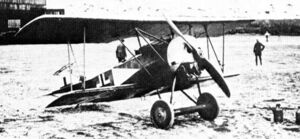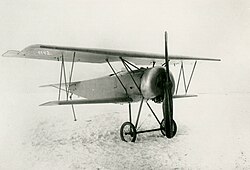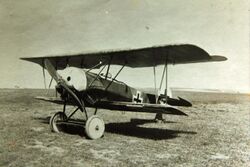Engineering:Fokker D.VI
| Fokker D.VI | |
|---|---|

| |
| Role | Fighter |
| Manufacturer | Fokker-Flugzeugwerke |
| Designer | Reinhold Platz |
| Primary user | Luftstreitkräfte |
| Number built | 59 |
The Fokker D.VI was a German fighter aircraft built in limited numbers at the end of World War I. The D.VI served in the German and Austro-Hungarian air services.
Design and development
In late 1917, Fokker-Flugzeugwerke built two small biplane prototypes designated V.13. These aircraft combined a set of scaled-down D.VII wings with a fuselage and empennage closely mirroring those of the earlier Dr.I.[1] The first prototype utilized an 82 kW (110 hp) Oberursel Ur.II rotary engine, while the second featured a 119 kW (160 hp) Siemens-Halske Sh.III bi-rotary engine.[2]
Fokker submitted both prototypes at the Adlershof fighter trials in late January 1918.[3] At that time, Fokker reengined the first prototype with the 108 kW (145 hp) Oberursel Ur.III.[3] Pilots found the V.13s to be maneuverable and easy to fly.[4] Idflieg issued a production contract after the V.13s were ultimately judged to be the best rotary powered entries of the competition.[4]
Operational history
The new aircraft, designated D.VI, passed its Typenprüfung (official type test) on 15 March 1918.[5] The production aircraft utilized the Oberursel Ur.II, which was the only readily available German rotary engine. Idflieg authorized low level production pending availability of the more powerful Goebel Goe.III.[5] Deliveries commenced in April and ceased in August, after only 59 aircraft had been completed.[6] Seven aircraft were delivered to the Austro-Hungarian Air Service (Luftfahrtruppen).
In service, the D.VI was hampered by the low power of the Oberursel Ur.II.[5] Moreover, the lack of castor oil and the poor quality of "Voltol," an ersatz lubricant, severely reduced engine life and reliability.[1] The D.VI remained in frontline service until September 1918, and continued to serve in training and home defense units until the Armistice.
Variants
- V.13/1 : First prototype, powered by a 108 kW (145 hp) Oberursel Ur.III rotary engine
- V.13/2 : Second prototype, powered by a 119 kW (160 hp) Siemens-Halske Sh.III rotary engine
Operators
 Austria-Hungary
Austria-Hungary
- Luftfahrtruppen
 German Empire
German Empire
- Luftstreitkräfte
 Kingdom of Hungary
Kingdom of Hungary
- Royal Hungarian Air Force - Postwar.
 Romania
Romania
- Romanian Air Corps - 6 captured during the war of 1919.[7]
Specifications
General characteristics
- Crew: one pilot
- Length: 6.25 m (20 ft 6 in)
- Wingspan: 7.66 m (25 ft 1 in)
- Height: 2.55 m (8 ft 4 in)
- Wing area: 17.7 m2 (190 sq ft)
- Empty weight: 393 kg (866 lb)
- Gross weight: 585 kg (1,290 lb)
- Powerplant: 1 × Oberursel Ur.II , 82 kW (110 hp)
Performance
- Maximum speed: 197 km/h (123 mph, 107 kn)
- Range: 300 km (186 mi, 162 nmi)
- Endurance: 1 hours 30 minutes
- Service ceiling: 6,000 m (19,680 ft)
Armament
- 2 × 7.92 mm (.312 in) LMG 08/15 "Spandau" machine guns
References
Notes
Bibliography
- Gray, Peter and Owen Thetford. German Aircraft of the First World War. London: Putnam, 1962. ISBN:0-933852-71-1
- Herris, Jack; Leckscheid, Jörn (2023). Fokker Aircraft of WWI: Volume 5: 1918 Designs, Part 1 - Prototypes & D.VI: A Centennial Perspective on Great War Airplanes. Great War Aviation Centennial Series. 55A. n.p.: Aeronaut Books. ISBN 978-1-953201-09-6.
- Taylor, Michael J. H. Jane's Encyclopedia of Aviation. London: Crescent Books, 1993. ISBN:0-517-10316-8.
- Weyl, A.R. Fokker: The Creative Years. London: Putnam, 1965. ISBN:0-85177-817-8.
 |




